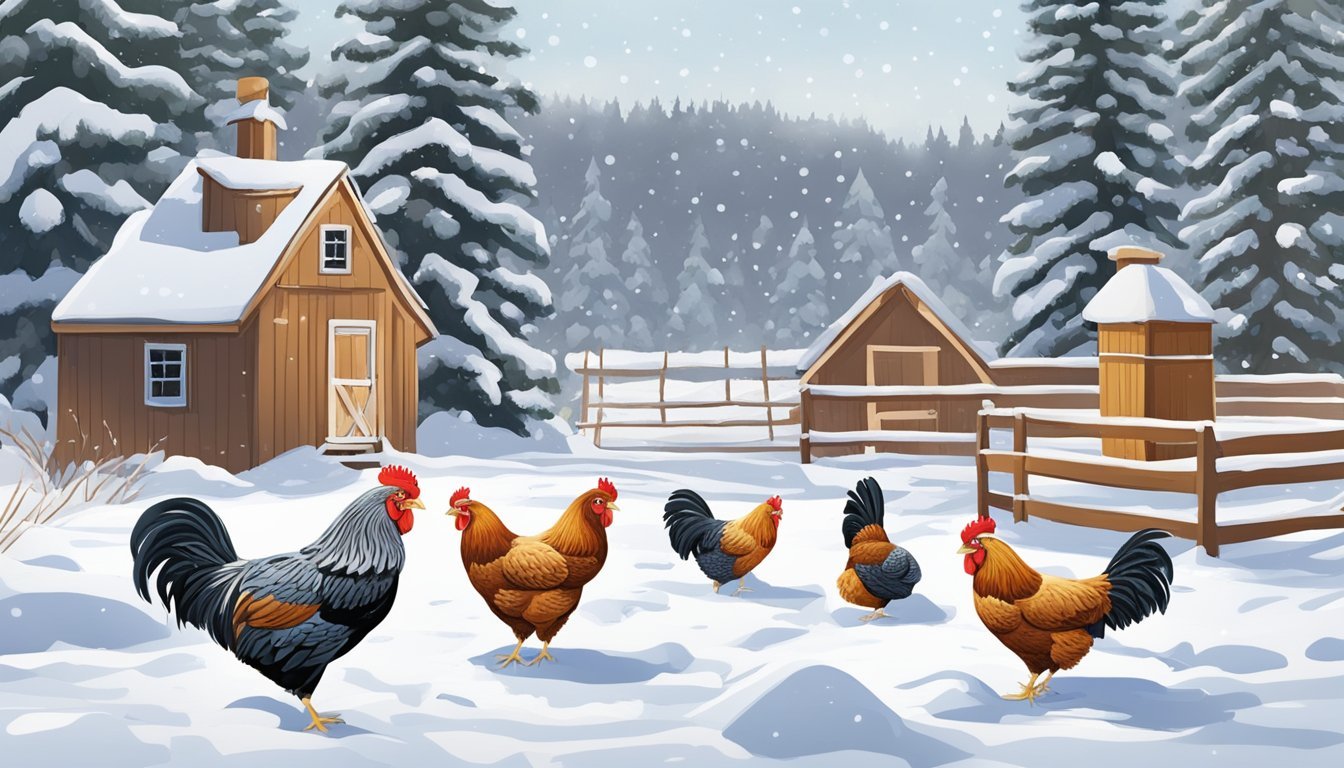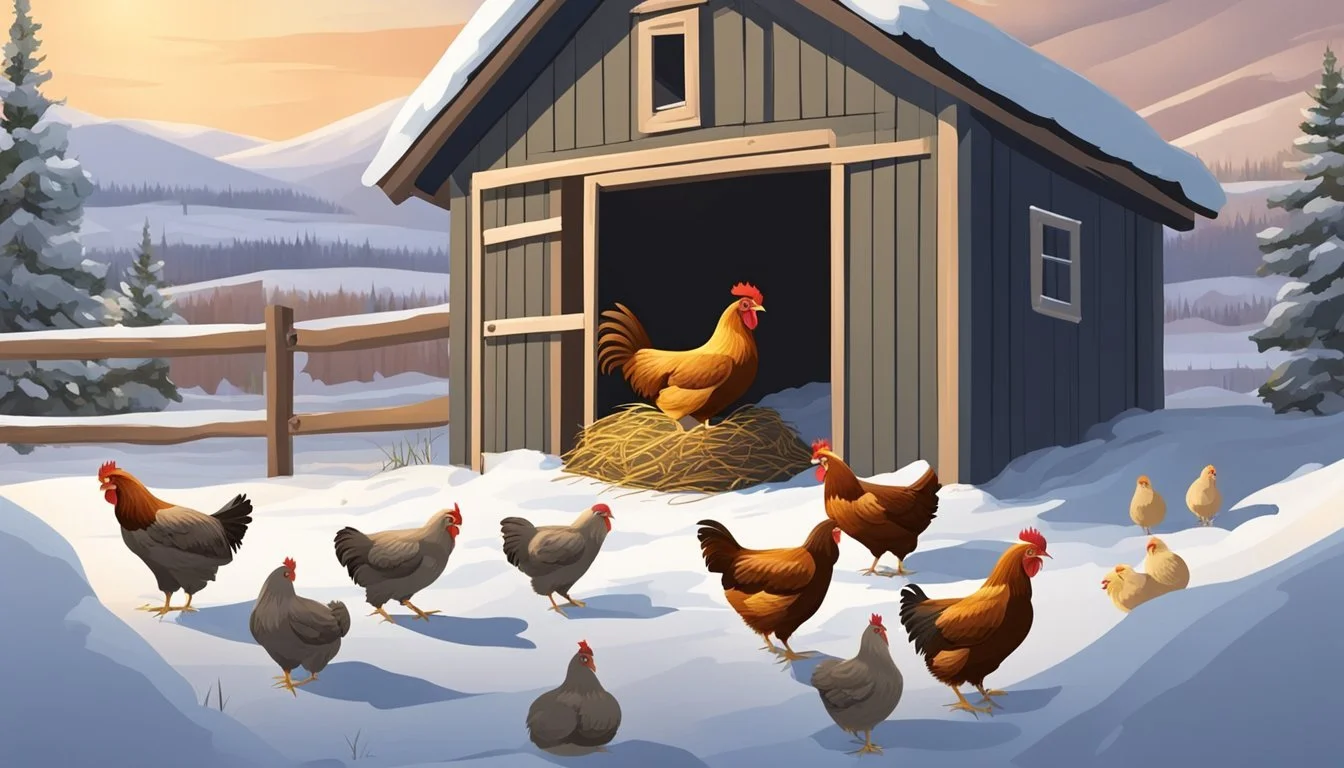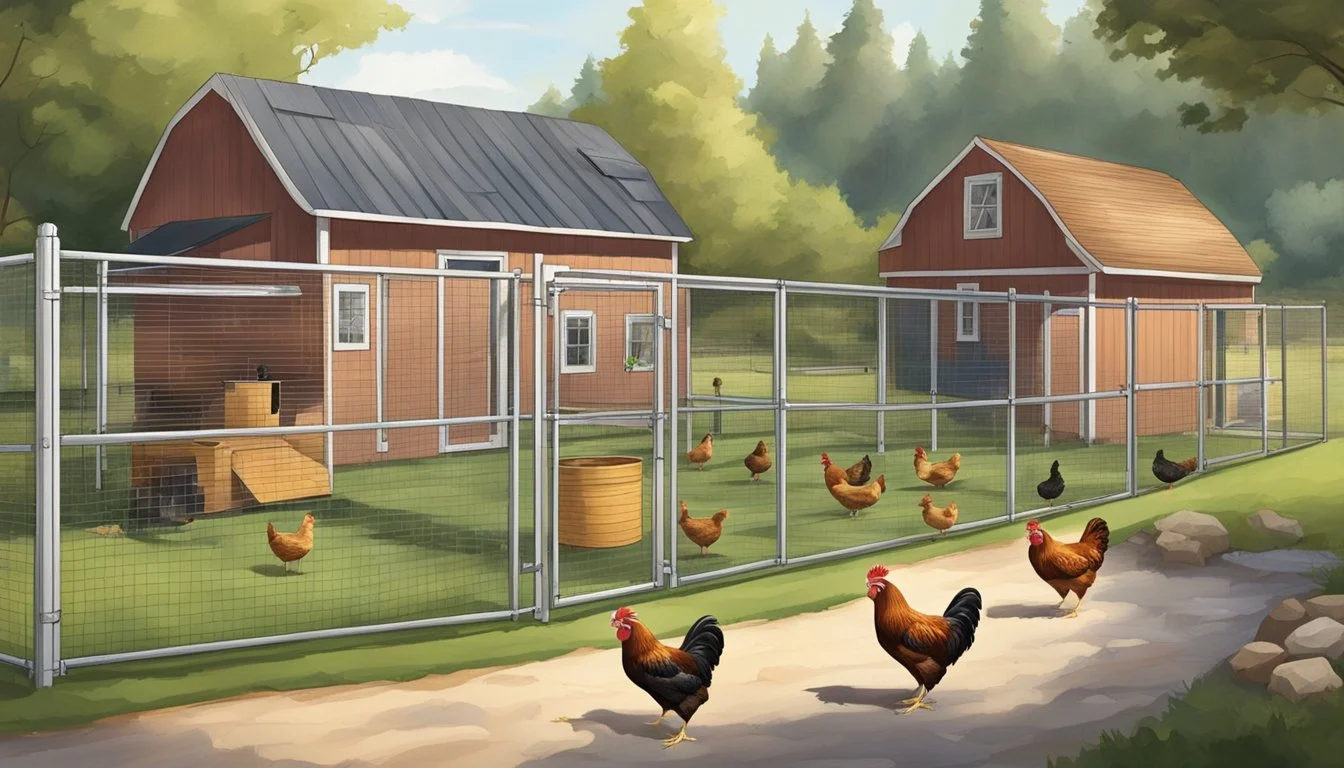Raising Backyard Chickens in Fairbanks, AK
Essentials for Cold Climate Coops
Raising backyard chickens in Fairbanks, Alaska, presents unique challenges and rewards. The extreme cold and lengthy winters require careful planning and accommodations, but the practice has become increasingly popular. Enthusiasts are drawn to the idea of fresh eggs, natural pest control, and the companionship that chickens provide. Many Fairbanks residents have found success by adapting their chicken-raising methods to handle the subarctic climate.
Ensuring the well-being of chickens in this northern environment means addressing their basic needs with a focus on shelter, food, and water. A well-insulated and ventilated coop is essential to protect the birds from Fairbanks' harsh winter temperatures, which can plummet to -40 degrees Fahrenheit. Selecting hardy breeds suited for cold weather, providing high-protein feed, and maintaining an unfrozen water supply are all part of the day-to-day care that keeps chickens healthy above the Arctic Circle.
Local regulations in the Fairbanks North Star Borough are generally accommodating towards the practice of keeping backyard chickens, though prospective poultry keepers should verify current rules with local authorities. Zoning laws typically permit chickens in residential areas, but specific guidelines may vary. It's this synthesis of rigorous care, strategic planning, and community support that has led to a growing culture of backyard poultry enthusiasts in Alaska's interior.
Getting Started
Raising backyard chickens in Fairbanks, Alaska requires preparation and understanding of the unique challenges posed by the local climate. Selecting appropriate chicken breeds and carefully introducing new chickens to your backyard flock are foundational steps for success.
Understanding the Local Climate
Fairbanks experiences extreme temperatures, with winters that can plunge to -40 degrees Fahrenheit. Chickens require a coop that offers protection from the cold and precipitation, which can span from September to May. It is crucial to ensure ample insulation and possibly a heat source within the coop to maintain a stable and frost-free environment for the poultry.
Selecting the Right Breeds
Not all chicken breeds are equal when it comes to withstanding the Alaskan cold. Hearty breeds like the Barred Rock, Rhode Island Red, and Ameraucana have proven to do well in Fairbanks. They possess the necessary characteristics to thrive in colder climates, including:
Barred Rock: Hardy, good egg layers, and adapt well to confinement.
Rhode Island Red: Robust layers, resilient, and manage cold climates efficiently.
Ameraucana: Known for their unique blue eggs, cold-hardy, and have a friendly demeanor.
When selecting breeds, one should focus on those with a history of adapting to similar climates to ensure the health and productivity of the flock.
New Member Introductions
Introducing new chickens to an existing flock requires careful management. Quarantine new birds for a minimum of 30 days to monitor for diseases and ease stress. Gradual introduction helps in establishing the pecking order while minimizing conflict. This process should be done with supervision and careful attention to the birds' behavior to prevent injuries and ensure a smooth transition.
Coop Basics
In the challenging weather of Fairbanks, Alaska, ensuring that chicken coops are well-designed and properly insulated is crucial for the health and productivity of backyard chickens.
Designing Your Coop
Space requirements are fundamental; each chicken needs at least 3 square feet inside the coop and 8-10 square feet in the run. The coop should be built from sturdy materials like plywood, which provides a good balance between durability and cost. The design must include ventilation to reduce humidity and prevent frostbite during the winter months without creating drafts. Secure measures, such as using hardware cloth instead of chicken wire, can protect chickens from predators.
Insulating for the Winter
For effective insulation, incorporating materials like rigid foam or fiberglass into the coop's construction helps maintain a stable temperature. Insulated coops prevent heat loss and reduce the need for supplemental heat sources. If additional warmth is necessary, one may use a heat lamp, but it's essential to install it securely to prevent fire hazards. Adequate insulation also allows chickens to safely generate body heat in the natural cluster without relying too heavily on heat lamps, which can sometimes lead to overheating if used excessively.
Chicken Care in Alaskan Conditions
Raising chickens in Fairbanks, Alaska, presents unique challenges due to the extreme temperatures and prolonged periods of darkness. Maintaining proper care ensures the health and productivity of the flock.
Feeding and Watering
To meet the high energy demands in cold weather, chickens require a protein-rich diet. A balanced commercial feed designed for cold climates is essential. Chickens' water needs particular attention — it must always be fresh and unfrozen. Water supply can be checked multiple times a day or a heated water system can be used to prevent freezing.
Managing Light and Heat
Given Fairbank's extreme variations in daylight, chickens need supplemental light for consistent egg production. Ideally, chickens should receive about 14 to 16 hours of light per day, which can be provided using a timed artificial lighting system. For heat, a well-insulated coop is crucial to retain warmth. Heat lamps can be utilized, but safety is paramount to prevent fire risks.
Preventing Frostbite and Disease
Frostbite is a real threat in Alaskan climates, especially on combs and wattles. To prevent it, ensure good ventilation in the coop to reduce moisture, yet avoid drafts. Applying a layer of petroleum jelly can offer protection on particularly cold nights. To prevent disease, cleanliness and regular health checks are imperative, along with a dry and draft-free environment to bolster the chickens' immune systems.
Egg Laying and Breeding
In Fairbanks, AK, understanding egg production and raising chicks are crucial elements for successful backyard chicken keeping. The harsh climates demand knowledgeable breeding and careful monitoring of laying patterns.
Understanding Egg Production
Backyard hens in Fairbanks typically start laying eggs at about 5 to 6 months of age and their laying cycle is influenced by factors like daylight hours and nutrition. A hen's peak laying period lasts for about two years.
Laying Frequency: Hens lay one egg approximately every 26 hours, not every day.
Daylight: At least 14 hours of light per day is ideal for consistent laying.
Winter: Supplemental light may be needed in winter months due to shorter daylight hours.
Feed for Layers: It's important to provide a high-protein feed to support egg production, as follows:
Starter feed: High in protein, suitable for chicks up to six weeks.
Grower feed: Reduced protein content, suitable for chickens from six weeks to laying age.
Layer feed: Balanced nutrients and calcium for laying hens.
Eggs from backyard chickens in Fairbanks can range in color and size, with many keepers selecting breeds for their distinctive eggs.
Raising Chicks
Raising chicks to layers or roosters requires specific care, starting from when they hatch and continuing as they grow.
Temperature: Maintain a brooder temperature around 95°F for the first week, reducing it by 5 degrees each week until reaching ambient temperature.
Space: Chicks require safe spaces protected from predators and adequate room to grow.
A rooster is not necessary for hens to lay eggs, but he facilitates breeding, ensuring the continuation of the flock. Roosters also contribute to the flock's social structure and can offer protection.
Safety and Welfare
Raising backyard chickens in Fairbanks, Alaska, requires due diligence to safeguard the flock's welfare and protect them against local wildlife. Consistent health checks and cleanliness, along with measures to deter predators, are paramount for a thriving chicken coop.
Protecting Against Predators
Fairbanks, known for its diverse wildlife, presents numerous challenges for backyard chickens. Predators such as hawks, ermine, foxes, and other ground predators pose significant risks. To deter these threats:
Erect sturdy fencing around the coop and run, burying it several inches into the ground to prevent digging by foxes.
Use wire mesh with openings no larger than 1/2 inch to secure the coop, as smaller predators can slip through larger gaps.
Add overhead netting or a solid roof to protect against hawks.
Install motion-activated lights or auditory deterrents to scare away nocturnal predators.
Minimizing odors that attract predators is also essential. This includes regular removal of food scraps and securing feed in airtight containers.
Maintaining Health and Cleanliness
Chickens require a clean environment and regular health monitoring to thrive. The following practices help maintain the flock's welfare:
Provide ventilated housing to prevent moisture buildup, which can lead to respiratory issues and attract pests.
Implement a regular cleaning schedule to remove droppings and replace bedding.
Offer nutritious feed and clean water, ensuring feeders and waterers are free from contamination.
Conduct routine health checks for signs of illness or injury.
By adhering to these strict safety and welfare practices, owners can ensure their Fairbanks flocks remain protected and healthy throughout the year.
Legal and Social Considerations
In Fairbanks, Alaska, aspiring poultry enthusiasts should be well-versed not only in the legalities of urban chicken keeping but also in the dynamics of neighborhood engagement and community involvement.
Zoning and Neighborhood Guidelines
Fairbanks residents interested in raising backyard chickens must first confirm that their residential zoning classification permits this activity. Most residential areas within the Fairbanks North Star Borough generally allow chickens, with specific rules or requirements occasionally in place. Homeowners should consult with local authorities, as guidelines can differ by neighborhood.
Key Points:
Verify chicken allowances within your specific residential area.
Check for any restriction or additional requirements that might apply.
Engaging with Local Poultry Communities
Participation in local poultry communities can provide valuable insights into the nuances of raising chickens in the northern climate. Forums such as "BackYard Chickens" offer discussion platforms where residents can exchange tips and share experiences. Social engagement within these forums not only supports the practical side of poultry keeping but also fosters a sense of camaraderie among Fairbanks chicken enthusiasts.
Key Points:
Seek advice from experienced members within local forums.
Share and learn best practices specific to Fairbanks.
Additional Considerations
When raising chickens in Fairbanks, owners must account for the unique environmental challenges and explore alternative poultry options, as well as free-range considerations.
Seasonal Challenges
In Fairbanks, chicken caretakers face extreme winter conditions that demand special attention for the flock's well-being. Insulated coops and heated waterers are essential to prevent freezing. They should monitor the amount of daylight; artificial lighting can supplement short winter days to maintain egg production. Chickens also require a diet high in energy to sustain them during the cold.
Season Consideration Action Required Winter Temperature Insulate coops, provide heat Winter Daylight Supplement with artificial light Winter Nutrition Increase feed's energy content
Alternative Poultry and Free-Range Options
While chickens are a popular choice, ducks may be a hardier option for Fairbanks as they cope better with wet conditions and are less likely to suffer from frostbite. For free-range poultry, a secure enclosure is crucial to protect from predators omnipresent in the 'Last Frontier'. Movable pens can allow birds to safely forage, which enriches their diet and well-being.
Duck Characteristics:
Better tolerance to cold
Resilient to wet ground conditions
Free-Range Considerations:
Predation from local wildlife
Need for movable, secure enclosures
Conclusion
Raising chickens in the unique climate of Fairbanks, Alaska, requires careful consideration and adaptation. Enthusiasts must ensure that chickens are provided with appropriate shelter, food, and water to thrive in the colder environment. The University of Alaska Fairbanks Cooperative Extension serves as a valuable resource for guidance on best practices.
Key Considerations for Fairbanks Chicken Owners:
Shelter: Insulated coops are essential to protect chickens from harsh winter temperatures.
Food: A high-protein diet is necessary—commercial feeds cater to chickens' nutritional needs.
Water: It must be kept unfrozen; heated waterers can be beneficial.
Predator Protection: With local wildlife posing a threat, secure fencing and enclosures are vital for chickens' safety.
Residents are encouraged to learn local regulations, as they play a significant role in backyard chicken keeping. One should always verify current rules with the Fairbanks North Star Borough to stay compliant.
Ultimately, with proper care, raising chickens in Fairbanks can be a rewarding endeavor, offering fresh eggs and the satisfaction of sustainable living. Those who embrace the challenges find a unique joy in aligning with the rhythms of nature in Alaska.









